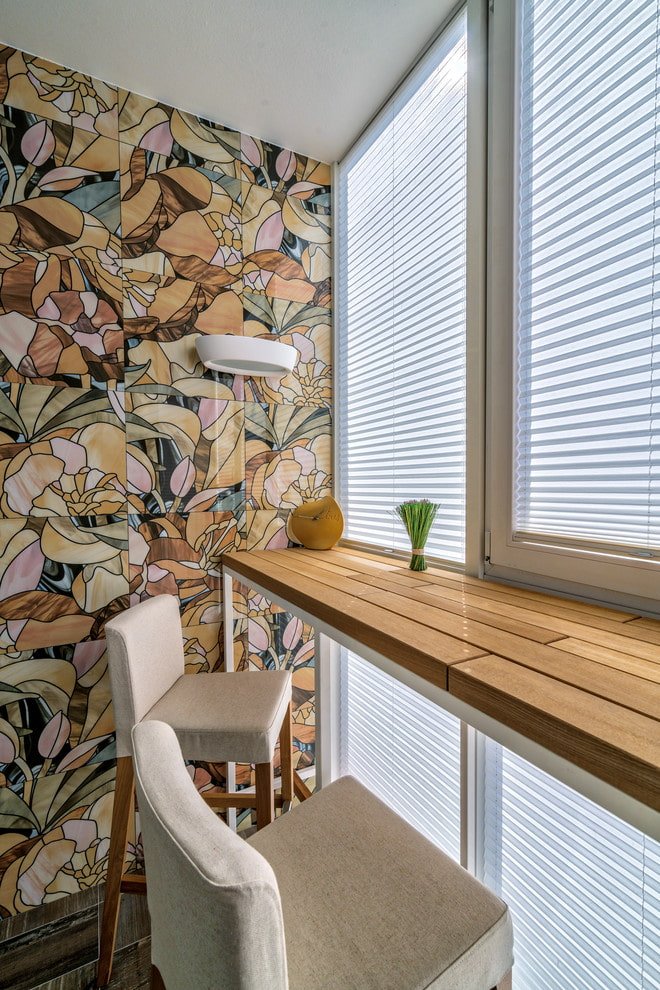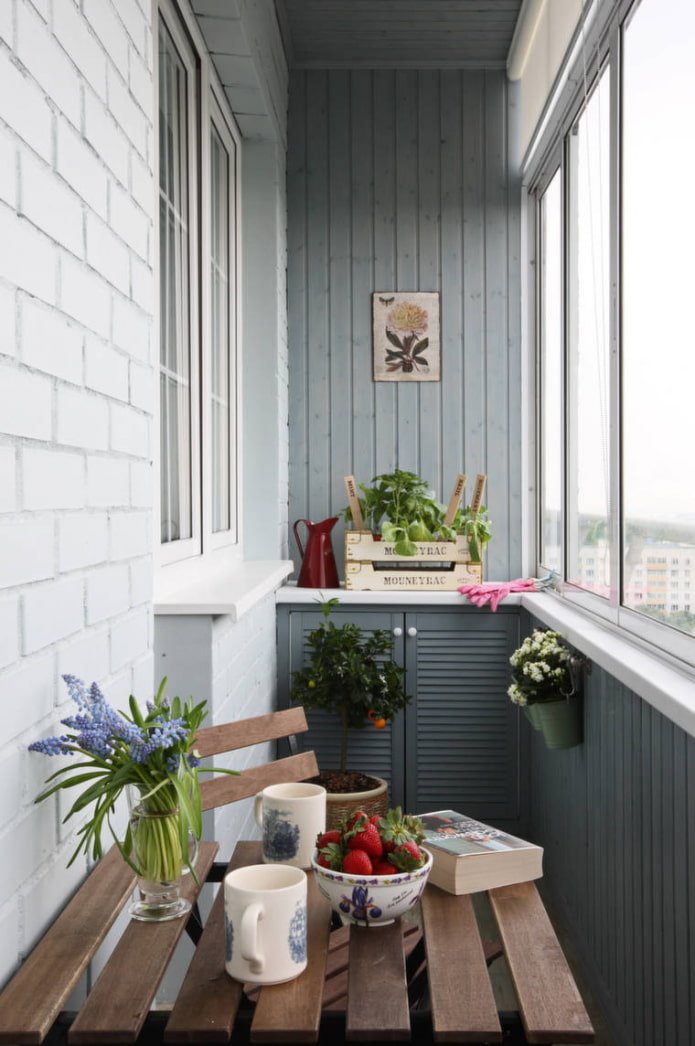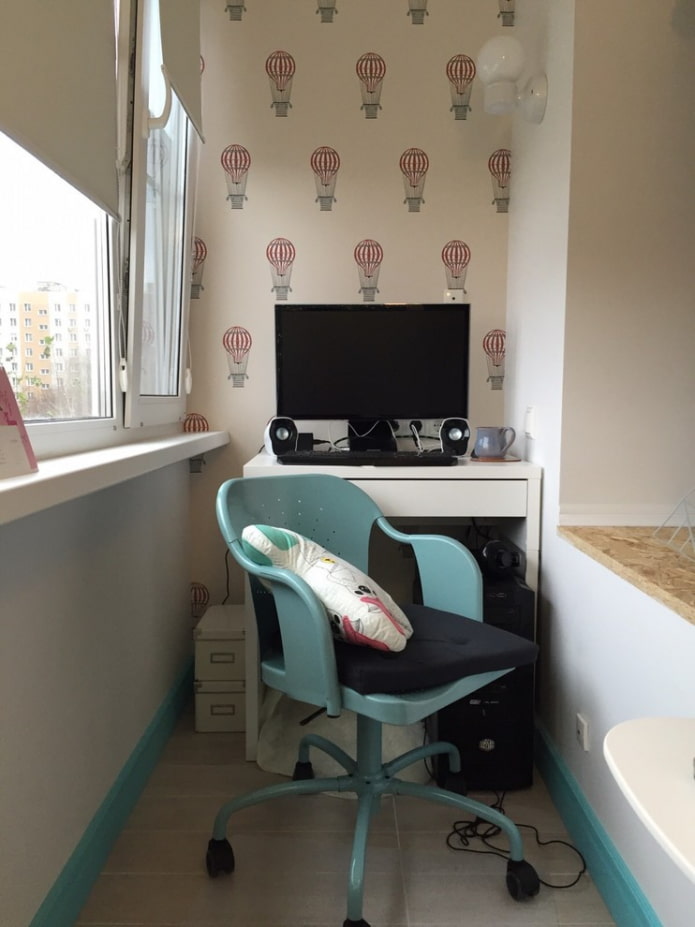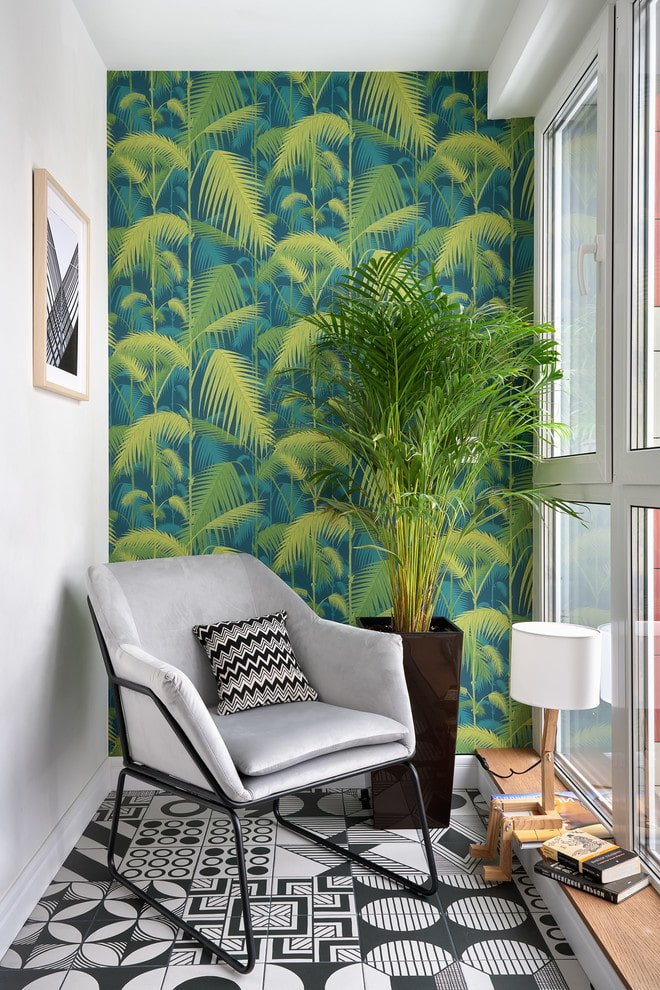Painting
Is the balcony open or glazed, cold or insulated so well that it has turned into a separate room? The choice of finishing materials depends on many factors. Painting is the most common way to transform the walls on the balcony.
You don’t need any special skills to paint.
Paint protects the surface from rotting and rust.
It’s easy to “lure the sun” onto a north-facing balcony by painting it in warm, bright colors. On the contrary, a south-facing balcony can be “refreshed” by using cool shades. Another great idea is to paint an accent wall with chalkboard paint and change the inscriptions and drawings depending on your mood.


Acrylic or oil paints, enamels, including alkyd ones, are suitable for balcony walls. Paint intended for outdoor use will last longer.



The photo shows a narrow balcony, the walls of which are painted white, which makes the space visually wider.
Decorative plaster
Textured coating that looks more expensive and elegant than paint. Goes well with decorative stone.
Moisture-resistant plaster based on silicone or cement is suitable for open balconies. When choosing it, you need to pay attention to the mark “For external work”.


Lime plaster, the texture of which resembles natural stone, is intended for glazed balconies. On heated loggias, a coating on a mineral or gypsum base is used.

The photo shows a place for rest and work, arranged on the loggia. Its walls are covered with plaster, thanks to which the interior looks cozy and warm.
Tiles
Finishing the walls of the loggia with ceramic tiles, despite the high cost of the material, is considered a popular method, but it also has both pros and cons.
If the room is small, it is advisable to cover it with small tiles. Large slabs make the balcony visually smaller; light-colored products will help to visually enlarge it. For the walls, you can choose either a matte or glossy finish.


Clapboard
Wooden clapboard is very common in our country – it is a natural material that gives the glazed loggia a homely warmth.
For finishing the balcony, it is recommended to buy Euro lining, since its lock is more reliable than that of ordinary material.


After the walls are covered, they can be painted in any color or varnished. Often, not only the walls, but also the ceiling are covered with clapboard.

The photo shows a loggia in an eco-style, which is supported by varnished clapboard and wooden furniture.
Cork
According to experts, covering the walls with cork creates an optimal microclimate on the loggia.
Before installing the panels, they must be left to lie in a dry room (about 2 days). Cork is glued to a flat surface and is suitable only for closed balconies.

The photo shows an insulated loggia with cork paneling.
Laminate
This is a wood fiber covering consisting of several layers. The top layer has protective and decorative properties. As a rule, laminate imitates wood of various species and colors, including aged wood.
Before sheathing the loggia, it is necessary to make warm glazing – specialists will help to solve this issue. You can carry out insulation and waterproofing work yourself by reading useful articles and watching training videos.


The most wear-resistant type of laminate is considered to be class 33 material.

The photo shows a loggia with laminated walls and floor.
Drywall
People who value practicality and time saving choose to cover their balconies with drywall. Plasterboard sheets can only be used to decorate the walls of an insulated loggia.
Without finishing, plasterboard walls look unfinished, so for an attractive design, they should be painted or decorated with decorative plaster.

The photo shows a loggia finished with moisture-resistant drywall sheets.
PVC panels
Plastic panels (or siding) are considered the most affordable material for finishing a balcony from the inside.
PVC panels are always attached to a frame made of metal profiles or wooden beams.


Plastic slats are attached both horizontally and vertically.
MDF panels
MDF lining or panels are the choice of those who value wood for its naturalness, but care about the durability of the finish.
Panels are mounted on a wooden lathing. This allows you to hide the insulation layer and uneven walls.


In addition to solid-pressed MDF panels, laminated products are widely used for finishing balconies. They are characterized by increased heat resistance, durability and ease of maintenance.

The photo shows a wall finished with laminated MDF panels that imitate processed wooden boards.
Decorative stone
Artificial stone is considered one of the most beautiful and effective ways to finish a balcony.
In terms of performance characteristics, it is not much inferior to natural stone, and sometimes even surpasses it.


Decorative brick is especially popular today. It gives the balcony a certain industrial feel, but at the same time it looks natural and stylish.

The photo shows a picturesque balcony, which is ennobled with the help of decorative stone.
Wallpaper
This is not the most practical type of finishing, since the service life of wallpaper on the balcony depends on the quality of its insulation.
In addition to conventional non-woven, paper and vinyl wallpaper, liquid or natural (bamboo) wallpaper is used for finishing. In accordance with the designer’s idea, you can also decorate the balcony with photo wallpaper, which will help to visually deepen the space.


Combined finishing
The use of several materials allows you to create a unique, and most importantly, practical design of the loggia.
Decorative plaster and artificial stone, paint and lining (MDF and laminate), paint and wallpaper, wood and decorative brick go well with each other.

The photo shows a loggia, the decoration of which harmoniously combines processed boards and white paint.
When combining types of decoration, it is worth creating a project in advance that will provide for several possible options: you can highlight one accent wall against a neutral background, decorate the area under the windowsill in a special way, or decorate the side walls and the floor in the same way. Imagination is limited only by the budget and the functional purpose of the balcony.


Now reading:
- Kitchen Buffet: 30 Design Ideas and Photos for Inspiration
- Linoleum for the kitchen: 50 inspiring photos and design ideas in bright and dark shades.
- Combining colors for kitchen interior: recommendations, tables and diagrams
- Kitchen design in a Khrushchevka: 96 photos for inspiration from renovation to style
- Hidden kitchens in the interior: pros, cons and 35 photo examples.